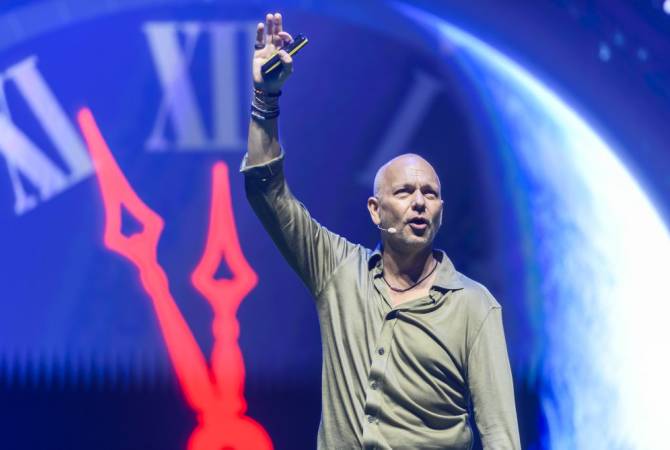From iPods to Space: Tony Fadell's quest to combat methane
 14:21, 15 May 2024
14:21, 15 May 2024BRATISLAVA, 15 MAY, ARMENPRESS. Over the past two decades, discussions on global warming have increasingly emphasized the critical need to reduce carbon dioxide emissions. Since the start of the Industrial Revolution, the level of carbon dioxide in the atmosphere has surged by 50 percent. This poses a severe threat to the planet's biodiversity, as high levels of carbon dioxide create a greenhouse effect that directly contributes to global warming. In response, major international organizations and leading nations are implementing various strategies to curb carbon dioxide emissions.
Recently, however, scientists have identified another gas that may be even more harmful and destructive to our environment: methane. The concentration of methane in the atmosphere has more than doubled over the last two hundred years. Experts now believe that methane is responsible for 20-30 percent of global warming.
American engineer and inventor Tony Fadell, best known for creating the iPod, has significantly contributed to identifying and reducing methane emissions in recent years.
Currently, much of Fadell's work focuses on promoting a sustainable future for Earth.
Speaking at the STARMUS festival in Bratislava, he explained how he became involved in combating methane emissions and highlighted the progress made so far.
"Armenpress" shares the key points from Tony Fadell's speech.
Space has always been a childhood dream
I’ve been building since a young age. I’ve always dreamed of Space. I saw the first shuttle launch when I was a kid. I was even born in the year of the first Apollo mission. So I’ve always grown up around the Space, but I have never done anything in Space. I’ve always dreamed of. But luckily 6-7 year ago I got a call to help build a satellite - a satellite that tracks methane around the globe.
Why is it important to detect methane emissions?
This is the first global satellite to track methane around the planet. Why is it important? It is not the biggest gas in the atmosphere. CO2 is; it’s 76 % of the global emissions every year. Methane is only 16 percent. The story is that methane is 80 times more powerful as a global warming gas than CO2. So yes, there is more CO2, but methane is a bigger problem, and it warms the Earth faster. And we have to address that as fast as possible, as well as we can. We can’t wait.
And we’re putting more methane into the atmosphere every day, just like CO2. It’s not going down. And we have to solve this problem as soon as we can. Why? Because we believe we can slow the rate of the global warming by 30% by just tracking and cutting methane. Going and finding the sources of methane, reducing them and shutting them off.
How does methane get into the atmosphere?
The number one cause for the leaks of methane, just like in the case of CO2, is the oil and gas industry. They are the number one cause in the US and worldwide. The second one after the oil and gas industry is agriculture, agricultural burps and farts. So we are focused, with our satellite, on looking at oil and gas emissions first, and next, we are going after agriculture.
After that there are landfills, where we dump all our trash. Our satellite will be able to cover all those. But first and foremost, we go over oil and gas, the fastest thing we can fix.
Now that we’ve been talking about this problem. The world didn’t know about methane problem 10 years ago.
After COP, the US and EU have woken up to this problem, and they have now impelemented all kinds of regulations, measures and fines for all those oil and gas producers to go after that and get that to fix the problems. That is amazing. This is amazing that 10 years ago, we were only talking about CO2, and now we are talking about methane, and we actually have legislation in place to fix it.
MethaneSat – our eye in the sky
There’s one issue. Where is the methane? Everybody sees there’s a problem, but where is it? We don’t have the global data until now.
Our mission with this satellite is to report where all the methane is, all of them, across the globe.
We can do that now with MethaneSat. Now we can have an eye in the sky checking up the entire globe for these missions.
We can even detect the location, we know how much and how fast these emissions happen every day.
MethaneSat is up there, it has been up there since March.
The satellite data will be free for researchers
Starting next month, we’re going to tell the world what we see. It orbits the globe every 95 minutes. And right now, it is focused on the top 80 percent of what we believe are the methane emitters on the planet. We will be able to recognize them, we’ll be able to tell the world about them.
But what’s also important is that the data from the satellite is free for researchers. The uncorrected, raw data will be available for anyone to use to help us with this search, with this hunt to help us figure out if maybe your neighbor has a methane leak, or maybe the industry or the company that you work for has a methane leak. We can all go and help stop these methane leaks. And any company that uses the data, they will have to pay for it. That’s how we continue to sustain this mission.
Araks Kasyan




















